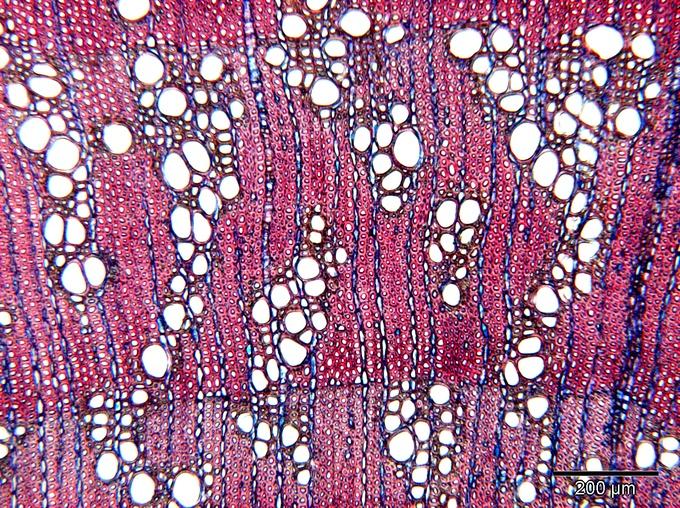
The Sapotaceae, or sapodilla, family is a large pantropical woody family of ca. 1100 species ranging in habit from small understory shrubs to large canopy trees. They thrive in humid, lowland tropics with high concentration of species in Amazonian South America, Malaysia, Madagascar, and New Caledonia (Pennington, 2004). Some genera are well-known for their economic value, such as Manilkara, Madhuca, Palaquium for their durable timber that is often traded, Chrysophyllum for fruits, Palaquium for latex, and Sideroxylon (former Argania) and Vitellaria for their oil-producing seeds. Surprisingly, the Sapotaceae family is poorly known from a wood anatomical point of view despite many species with very heavy tropical woods. Therefore, Vicky Beckers is working on a comparative wood anatomical study of Sapotaceae, focusing on unravelling the evolutionary and ecological patterns.
Background& context
Despite the economic importance of this family of hardwoods, knowledge on the wood anatomy is scattered and often non-published. In his 36 short publications on the wood anatomy of neotropical Sapotaceae, Kukachka described woods of many neotropical species (Kukachka, 1978-82); African species have been described in the unpublished PhD thesis of Lens (2005), and Asian species are investigated in Budi’s unpublished PhD thesis (1993). There are a number of typical wood anatomical traits in the family (vessel multiples in radial multiples or clusters, short and narrow rays, and two types of vessel-ray pitting), while the presence and type of mineral inclusions are highly variable and presumably phylogenetic informative (Lens, 2005).
Objectivesand goals
The proposed MSc proposal will help contributing to a wood anatomical review of the entire family based on available and new descriptions, and confront the wood anatomical traits with available molecular phylogenies to trace evolutionary patterns in the microscopic wood anatomy. Wood samples from our huge wood collection in Naturalis will be collected, sectioned, and described. Ancestral state reconstruction of selected phylogenetically informative traits will performed based on the latest molecular phylogeny.

Materialand methods
Light microscope and scanning electron microscope techniques are central, and lab work (sectioning wood into microscopic slides and preparing maceration slides) will be needed to carry out all the observations required to make detailed descriptions of about 50 species. The trait reconstruction will be performed based on the available molecular phylogenies.
Studentrequirements
The candidate should be able to work accurately to make good descriptions, and enjoy working with microscopes. The descriptions will be added to a scientific publication.
Projectreferences
Budi AS. 1993. Struktur des sekundären xylems und taxonomie des Südasiatisch-Pazeifischen Sapotaceae. Unpublished PhD thesis, University of Hamburg, Germany.
Kukachka B.F. 1978-1982. “Wood anatomy of the neotropical Sapotaceae. I-XXXVIII.” U.S Dept. Agric., For. Prod. Lab., Research Papers.
Lens, F. 2005. “Systematic significance of wood anatomical characters in Ericales.” PhD Thesis. Laboratorium voor Systematiek, KU Leuven, Leuven.
Pennington, T.D. 2004. “Sapotaceae”. in Kubitzki K. (ed.), Families and genera of vascular plants. Berlin: Springer-Verlag 4: 390-421.